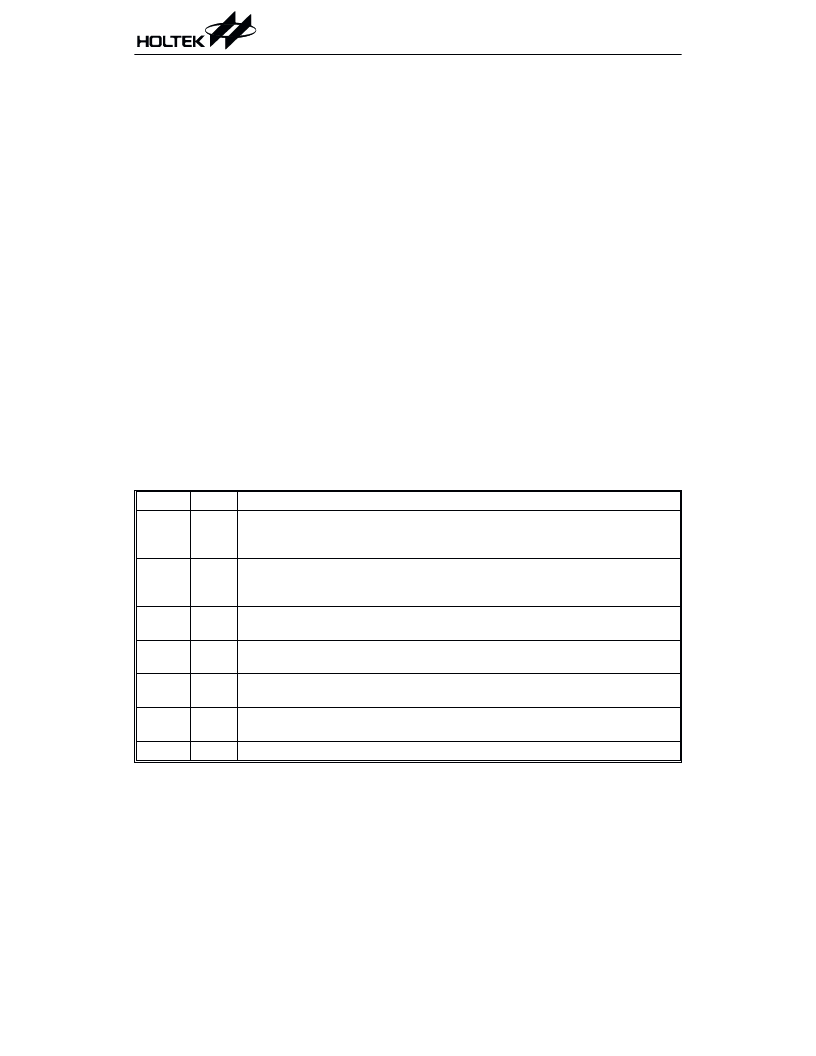- 您現(xiàn)在的位置:買賣IC網(wǎng) > PDF目錄385399 > HT46R47 (Holtek Semiconductor Inc.) 8-Bit OTP Battery Charger Controller PDF資料下載
參數(shù)資料
| 型號: | HT46R47 |
| 廠商: | Holtek Semiconductor Inc. |
| 英文描述: | 8-Bit OTP Battery Charger Controller |
| 中文描述: | 8位檢察官電池充電器控制器 |
| 文件頁數(shù): | 10/45頁 |
| 文件大?。?/td> | 588K |
| 代理商: | HT46R47 |
第1頁第2頁第3頁第4頁第5頁第6頁第7頁第8頁第9頁當(dāng)前第10頁第11頁第12頁第13頁第14頁第15頁第16頁第17頁第18頁第19頁第20頁第21頁第22頁第23頁第24頁第25頁第26頁第27頁第28頁第29頁第30頁第31頁第32頁第33頁第34頁第35頁第36頁第37頁第38頁第39頁第40頁第41頁第42頁第43頁第44頁第45頁

HT46R47
Rev. 1.40
10
July 18, 2001
status information and controls the operation
sequence.
With the exception of the TO and PD flags,
bits in the status register can be altered by
instructions like most other registers. Any
data written into the status register will not
change the TO or PD flag. In addition opera-
tions related to the status register may give
different results from those intended. The
TO flag can be affected only by system
power-up, a WDT time-out or executing the
"CLR WDT" or "HALT" instruction. The PD
flag can be affected only by executing the
"HALT" or "CLR WDT" instruction or a sys-
tem power-up.
The Z, OV, AC and C flags generally reflect the
status of the latest operations.
In addition, on entering the interrupt sequence
or executing the subroutine call, the status reg-
ister will not be pushed onto the stack automat-
ically. If the contents of the status are
important and if the subroutine can corrupt the
status register, precautions must be taken to
save it properly.
Interrupt
The device provides an external interrupt, in-
ternal timer/event counter interrupt and A/D
converter interrupts. The Interrupt Control
Register (INTC;0BH) contains the interrupt
control bits to set the enable/disable and the in-
terrupt request flags.
Once an interrupt subroutine is serviced, all
the other interrupts will be blocked (by clearing
the EMI bit). This scheme may prevent any fur-
ther interrupt nesting. Other interrupt re-
quests may happen during this interval but
only the interrupt request flag is recorded. If a
certain interrupt requires servicing within the
service routine, the EMI bit andthecorrespond-
ing bit of INTC may be set to allow interrupt
nesting. If the stack is full, the interrupt request
will not be acknowledged, even if the related in-
terrupt is enabled, until the SP is decremented.
If immediate service is desired, the stack must
be prevented from becoming full.
All these kinds of interrupts have a wake-up ca-
pability. As an interrupt is serviced, a control
transferoccursbypushingtheprogramcounter
onto the stack, followed by a branch to a sub-
routine at specified location in the program
memory. Only the program counter is pushed
onto the stack. If the contents of the register or
status register (STATUS) are altered by the in-
terrupt service program which corrupts the de-
Labels
Bits
Function
C
0
Cissetiftheoperationresultsinacarryduringanadditionoperationorifabor-
row does not take place during a subtraction operation; otherwise C is cleared. C
is also affected by a rotate through carry instruction.
AC
1
ACissetiftheoperationresultsinacarryoutofthelownibblesinadditionorno
borrow from the high nibble into the low nibble in subtraction; otherwise AC is
cleared.
Z
2
Z is set if the result of an arithmetic or logic operation is zero; otherwise Z is
cleared.
OV
3
OV is set if the operation results in a carry into the highest-order bit but not a
carry out of the highest-order bit, or vice versa; otherwise OV is cleared.
PD
4
PD is cleared by system power-up or executing the "CLR WDT" instruction. PD
is set by executing the "HALT" instruction.
TO
5
TO is cleared by system power-up or executing the "CLR WDT" or "HALT" in-
struction. TO is set by a WDT time-out.
6, 7
Unused bit, read as "0"
Status register
相關(guān)PDF資料 |
PDF描述 |
|---|---|
| HT46R65-100 | A/D with LCD Type 8-Bit MCU |
| HT46C65 | A/D with LCD Type 8-Bit MCU |
| HT46C65-100 | A/D with LCD Type 8-Bit MCU |
| HT46C65-52 | A/D with LCD Type 8-Bit MCU |
| HT46C65-56 | A/D with LCD Type 8-Bit MCU |
相關(guān)代理商/技術(shù)參數(shù) |
參數(shù)描述 |
|---|---|
| HT46R47(18DIP-A) | 制造商:未知廠家 制造商全稱:未知廠家 功能描述:Analog IC |
| HT46R47(18SOP-A) | 制造商:未知廠家 制造商全稱:未知廠家 功能描述:Analog IC |
| HT46R47E | 制造商:HOLTEK 制造商全稱:Holtek Semiconductor Inc 功能描述:Cost-Effective A/D Type 8-Bit MCU |
| HT46R47-H | 制造商:HOLTEK 制造商全稱:Holtek Semiconductor Inc 功能描述:Cost-Effective A/D Type 8-Bit OTP MCU |
| HT46R48 | 制造商:HOLTEK 制造商全稱:Holtek Semiconductor Inc 功能描述:Cost-Effective A/D Type 8-Bit OTP MCU |
發(fā)布緊急采購,3分鐘左右您將得到回復(fù)。